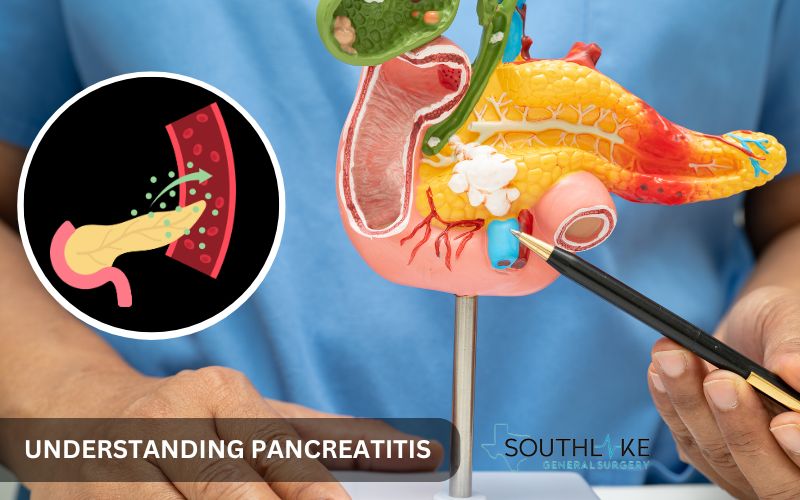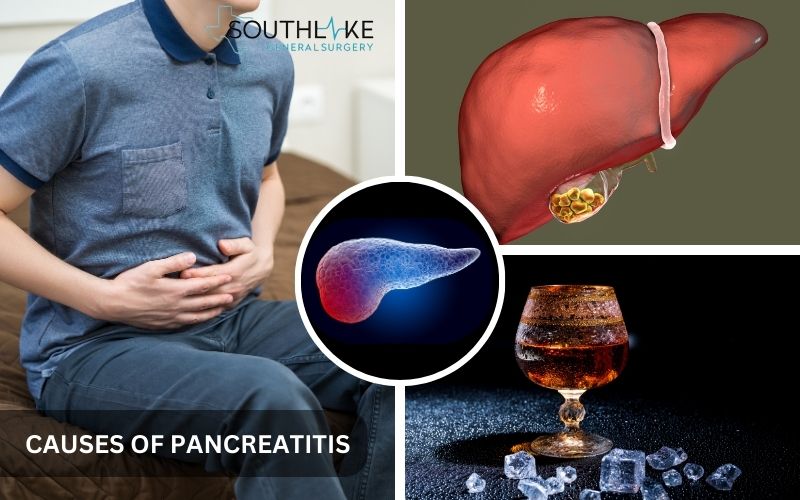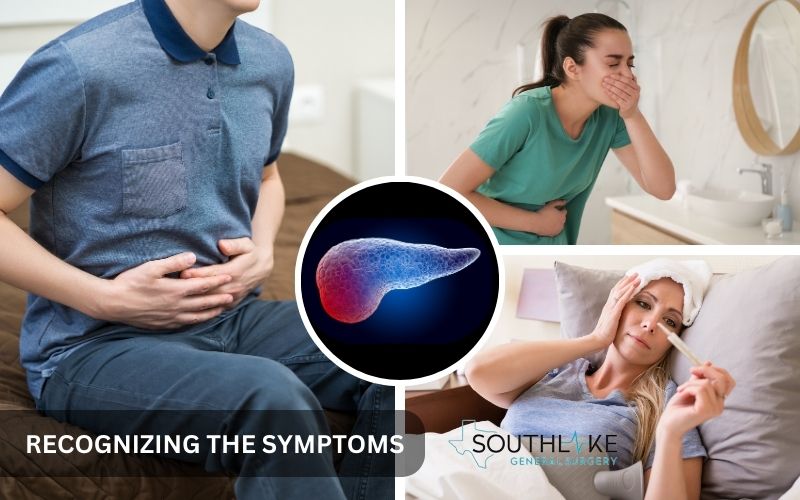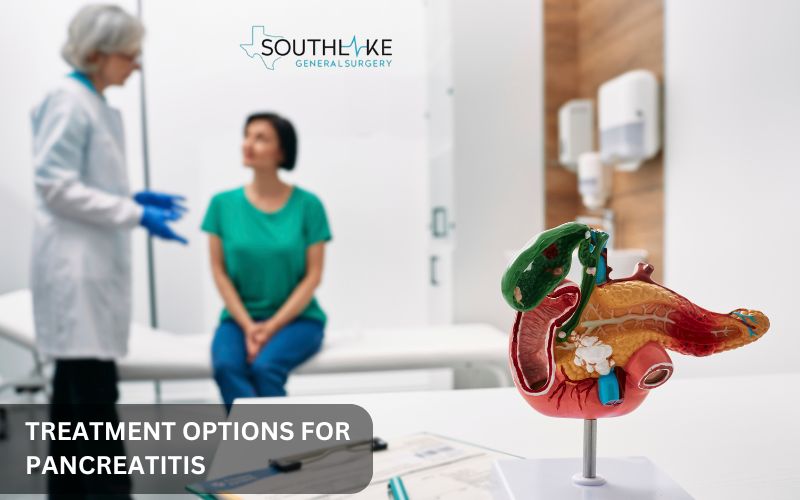Pancreatitis treatment can include various methods to help manage symptoms. It’s important to understand this condition to develop the right treatment plans. Acute pancreatitis needs quick medical attention to prevent complications of acute pancreatitis and further problems.
On the other hand, chronic pancreatitis needs longer-term care. By learning about the causes, symptoms, and treatments, people can act early. You can talk to healthcare professionals, like Dr. Valeria Simone, for advice that fits your needs. Stay informed about pancreatitis treatment to feel better and improve your health.
Key Highlights
- Pancreatitis happens when the pancreas becomes inflamed. This organ is key for digestion and for managing blood sugar levels.
- There are two kinds of pancreatitis: acute pancreatitis, which is short-term, and chronic pancreatitis, which lasts longer and gets worse over time.
- Common signs of pancreatitis include abdominal pain, nausea, vomiting, and fever. The pain often moves to the back.
- The main causes of pancreatitis are gallstones and alcohol consumption.
- Treatment can vary based on the type and severity of pancreatitis. It often includes pain relief, a diet change, and addressing the underlying cause.
Understanding Pancreatitis
The pancreas is an organ in your belly. It helps with digestion and controls blood sugar. It makes digestive enzymes and hormones. These substances move through ducts to the small intestine. In the small intestine, they help break down food and control blood sugar levels.
When a person has pancreatitis, the pancreas does not work properly. It gets swollen. This can cause the enzymes to start their job too early. As a result, they can harm the pancreas, leading to pain and problems with digestion.
What Is Pancreatitis?

Pancreatitis means the pancreas is swollen. This swelling can happen in two ways: acute or chronic.
Acute pancreatitis happens suddenly and usually doesn’t last long. It can cause mild pain, but it can also be very serious and even life-threatening. The good news is that most people with acute pancreatitis feel better when they get the right treatment.
Chronic pancreatitis is different from acute pancreatitis. It is a long-lasting inflammation of the pancreas, and understanding the causes of acute pancreatitis is crucial. This condition usually follows several episodes of acute pancreatitis or results from heavy alcohol use over many years.
Chronic pancreatitis can cause serious complications and damage to the pancreas. This damage makes it hard for the pancreas to work properly.
Acute vs. Chronic Pancreatitis: Key Differences

It is very important to know the difference between acute and chronic pancreatitis. This will help us manage these conditions better.
- Mild and acute pancreatitis often improves with minimal treatment. However, severe acute pancreatitis can result in issues like tissue damage or infection.
- Chronic pancreatitis is a long-term condition that requires ongoing care to manage symptoms and prevent further damage.
Causes of Pancreatitis
Finding the main cause is key for diagnosing and treating pancreatitis. The ways these causes lead to pancreatitis can be complex and confusing. However, knowing these risk factors is important to help prevent the condition.
Gallstones and heavy alcohol consumption are the leading causes of pancreatitis. Together, they cause many cases. Other factors can also add to this issue, even though they happen less often. It is important not to overlook these other factors.
The Role of Gallstones and Alcohol

Gallstones are small, hard pieces that can develop in the gallbladder. They can block the bile duct, which connects to the pancreatic duct. When the bile duct is blocked, pancreatic enzymes can build up. This buildup can irritate the pancreas and cause inflammation.
A major risk factor for pancreatitis is drinking too much alcohol. When people drink heavily, it can affect how the pancreas functions. This may cause digestive enzymes to activate too early. As a result, these enzymes can harm the pancreas.
Drinking a moderate amount of alcohol can be safe for some people. However, drinking too much alcohol, especially binge drinking, can greatly increase the chance of getting pancreatitis. This condition can cause serious problems in some cases.
Other Contributing Factors
Gallstones and heavy alcohol use are the main causes of pancreatitis. However, additional elements must be considered too. These include:
- Genetics: If someone in your family has had pancreatitis, you might have a higher risk factor for it.
- Certain Medications: A few medications can bother the pancreas. This may lead to drug-induced pancreatitis, but it is rare.
- High Levels of Triglycerides: High levels of triglycerides, which are fats in the blood, can be a risk factor for pancreatitis.
- Other Medical Conditions: Some health issues like cystic fibrosis, high blood calcium, and autoimmune diseases can also increase the risk factor for pancreatitis.
Recognizing the Symptoms
Recognizing the signs of pancreatitis is very important. It allows you to get medical help quickly. If you notice the signs early and begin treatment, you can have better results. This also reduces the chance of complications.
The symptoms can be different for acute and chronic pancreatitis. It is important to know the common symptoms of pancreatitis. By doing this, you can get medical help when you need it.
Early Signs of Pancreatitis

The main sign of acute pancreatitis is stomach pain, which can be dull or sharp. Seek help quickly if you experience this pain, especially after eating fatty foods. The location of the pain can indicate the issue; many feel it in the upper abdomen, sometimes radiating to the back. Other symptoms include:
- Nausea
- Vomiting
- Loss of appetite due to the inflamed pancreas affecting digestion
When digestive enzymes harm the pancreas instead of breaking down food in the small intestine, it leads to severe symptoms and pain.
Symptoms That Require Immediate Medical Attention
Some people may feel mild symptoms. However, others can feel severe abdominal pain. They may also have a high fever, a fast heartbeat, and vomiting. These symptoms need immediate medical help.
- Severe abdominal pain
- High fever
- Fast heartbeat
- Continuous vomiting
In serious cases, pancreatitis can cause a bad condition known as systemic inflammatory response syndrome (SIRS). This means that swelling affects more than just the pancreas. It might ultimately result in the failure of organs.
- It is very important to see these warning signs.
- Getting medical help right away can prevent bigger problems.
- It can also help you get better completely.
Diagnosis of Pancreatitis
Accurate diagnosis is key for treating pancreatitis. Doctors check how serious the condition is by looking at medical history, doing physical exams, and using special tests. This information helps them come up with a solid treatment plan. It also reduces the chance of long-term problems.
Laboratory Tests and Imaging
Diagnosing pancreatitis is tricky. The process involves:
- Blood tests to check enzyme levels
- CT scan to identify issues like swelling, inflammation, or fluid accumulation around the pancreas
- Ultrasounds or MRCP tests if gallstones are suspected
Advanced Diagnostic Techniques
Your doctor may recommend an endoscopic retrograde cholangiopancreatography (ERCP) if there are concerns about alcohol-related issues, particularly blockages in the pancreatic duct. This test involves sedation and the insertion of a thin tube with a camera through your mouth, down your esophagus, into your stomach, and reaching the small intestine.
- The doctor can use this tube to look closely at the pancreatic duct and bile duct.
- They can inject a dye to help make these areas clearer on an X-ray.
- The doctor can also fix problems by removing gallstones or putting stents to clear any blockages.
These advanced tests assist doctors in understanding the problem better. They are essential for choosing the right treatment. This is particularly important if you have chronic pancreatitis or if simpler tests do not give clear results.
Treatment Options for Pancreatitis
Managing pancreatitis is now easier. Treatment’s primary goal is to ease symptoms. It also focuses on finding the underlying cause of the inflammation. Lastly, it helps to solve any issues that may come up.
For mild cases, doctors often recommend simple treatments that can help. However, if the cases are severe, a hospital stay may be necessary. In some situations, surgery could also be needed.
Initial Management Strategies

Initial care involves resting the pancreas for healing, often requiring hospitalization for acute cases. Doctors monitor and provide pain relief, ensuring hydration with IV fluids and supportive treatment as needed.
In some cases, a feeding tube is necessary to aid healing by delivering food to the small intestine. This is crucial for patients unable to eat or drink due to symptoms like nausea or pain. These actions promote proper nutrition, pain reduction, and symptom resolution, aiding in a quicker recovery.
Typically, individuals with mild acute pancreatitis show progress within a week and can be discharged with dietary recommendations and follow-up arrangements.
Surgical Interventions
Most cases of pancreatitis can be treated without surgery. However, sometimes surgery is needed. For example, if gallstones block the bile duct and cause pancreatitis, a common solution is gallbladder removal surgery.
In severe cases of acute pancreatitis, surgery might be necessary. This is key when there are problems such as pancreatic necrosis or infected fluid around the pancreas. The surgery removes dead tissue and fluid. This helps prevent more infections and aids in the healing process.
Surgery has some risks. But it is done to fix the main problem, stop serious issues, and improve the patient’s health over time.
Managing Diet and Nutrition
Diet changes are crucial for pancreatitis, both acute and chronic, to reduce strain on the pancreas and aid recovery. Making lasting dietary changes is essential for managing symptoms and preventing nutritional issues in chronic pancreatitis.
Dietary Adjustments for Pancreatitis Patients
Diet changes are very important for handling pancreatitis. A low-fat diet is usually recommended, especially when you start. This type of food is easier for the small intestine to digest. It reduces the work the pancreas needs to do in making digestive enzymes, allowing it to rest.
- Pay attention to a balanced diet that has fruits, vegetables, and whole grains.
- These foods give you important vitamins, minerals, and fiber. They are good for your health and help you digest better.
Staying hydrated is really important. If you don’t drink enough water, it can make pancreatitis worse. Eating smaller meals more often is usually better than having large meals. Smaller meals put less stress on the digestive system and the pancreas.
Supplements and Nutritional Support
Chronic pancreatitis affects how the pancreas produces digestive enzymes, causing nutrient deficiencies, weight loss, and malnutrition. To address this, your doctor might recommend:
- Taking enzyme supplements with meals
- Using a feeding tube in severe cases of malnutrition or inability to eat adequately
These interventions benefit individuals with chronic pancreatitis by:
- Enhancing nutrition
- Managing weight
- Enhancing quality of life
Consulting a dietitian is recommended for personalized meal plans that suit your requirements and preferences.
Pain Management Techniques
Pain management is important when it comes to treating pancreatitis pain. It can make people feel better. Pain can range from mild discomfort to severe pain, which may require hospital care. A systematic review and good treatment plan are created by a team of experts. They consider both the physical and emotional aspects of pain.
Medications for Pain Relief
For pain relief, doctors usually suggest over-the-counter pain relievers. In severe cases, they may prescribe stronger medicine. This could include opioids, but it is important to use them carefully. They can have side effects.
Non-steroidal anti-inflammatory drugs, known as NSAIDs, can reduce pain and swelling. However, if you have pancreatitis, it’s important to be cautious with these medicines. They can raise the risk of stomach bleeding.
Good pain management is very important. It helps people do their daily tasks. It also improves their quality of life. This support is key for their overall treatment.
Alternative Pain Management Strategies
Using treatments other than medicine can help manage pain. Acupuncture and relaxation techniques are good choices. Engaging in deep breathing exercises and practicing meditation can yield positive outcomes. You can try these methods together with your usual care.
Managing pain from chronic pancreatitis can take time. Doctors may explore different treatment options. One method is an endoscopic ultrasound-guided celiac plexus block. This procedure works to block pain signals coming from the pancreas.
The goal is to improve life for everyone. We want people to take part in their own healing. This can help reduce the pain they feel every day.
Preventing Pancreatitis Flare-Ups
Preventing pancreatitis from returning is important, whether it’s a serious or long-term case. Changing your habits can reduce the chances of stomach pain and attacks. By doing this, you can keep your pancreas healthy for a longer time.
Lifestyle Modifications

- Making changes to your lifestyle is very important for preventing health problems in the future.
- It is crucial to stay away from alcohol, especially for those who have alcohol-induced pancreatitis.
- Quitting smoking is another important step.
- Smoking can harm the pancreas and slow down the healing process.
Eating a healthy diet is crucial. Include fruits, veggies, and whole grains. Avoid fatty, spicy foods. This diet helps maintain weight and reduces gallstone risk, a common pancreatitis cause. Exercise regularly, even a bit. It aids weight management, stress reduction, and improves health.
These actions lower the pancreatitis recurrence risk. Initially challenging, lifestyle changes benefit pancreas health and prevent future issues, including issues related to the first part of the small intestine. Putting in effort now is wise for later well-being.
Regular Medical Check-Ups and Monitoring
People who have had episodes of acute pancreatitis should see their doctors regularly. These check-ups help doctors keep track of the pancreas’s health. They can find problems early and change the treatment if needed.
- Checking your health might mean getting blood tests to check how your pancreas enzymes are working.
- It may also require imaging tests to look at your pancreas and any symptoms you feel.
- Make sure to tell your doctor right away if you have any new or worsening symptoms.
- Acting quickly can help avoid problems and boost your long-term health.
It is really important to talk to a doctor before you begin taking any new medicines or supplements. Some of these can affect how the pancreas operates. They can also interact with your current treatments. This interaction might raise the chance of having another episode of pancreatitis.
Long-Term Outlook for Pancreatitis Patients
The outcome for pancreatitis patients depends on the illness type, severity, complications, and overall health. Acute pancreatitis can lead to full recovery with proper treatment. Chronic pancreatitis necessitates ongoing care to manage symptoms and prevent further damage. Lifestyle changes, medical support, and assistance can enhance patients’ quality of life.
Managing Chronic Conditions
Living with chronic pancreatitis means you must make big changes to your lifestyle. You have to stick to a low-fat diet closely. It’s also very important to stay away from alcohol and smoking. These changes are very important for most people.
- Check your blood sugar levels often. This is very important.
- Stay hydrated and consume smaller portions consistently. This can help with symptoms and support the pancreas.
- Work with your healthcare team. This may include a gastroenterologist, a dietitian, and a pain specialist.
- Be sure to go for regular checkups.
- Take your medicine as your doctor says. Tell your healthcare provider about any new or worse symptoms.
- Good communication is key. It helps improve the quality of life for people with chronic pancreatitis.
Conclusion
Treatment for pancreatitis includes going to the doctor and making lifestyle changes. Doctors need to help with symptoms and find the cause for each person. Regular check-ups are important to see how you are doing and to prevent any problems. New medical options, like endoscopic procedures, can help patients feel better.
Getting quick medical help, changing your diet, and avoiding things like heavy drinking can help manage the condition. Focus on your health and work with healthcare providers to improve your well-being and quality of life.
Make an Appointment
If you need expert help with pancreatitis, you can visit Dr. Valeria Simone, MD, at Southlake General Surgery in Texas, USA. To make an appointment, just call +1 (817) 748-0200.
Dr. Simone helps with both acute pancreatitis and severe cases. She provides complete care, even in difficult situations. With her experience, you can get support for pain relief, treatment options, and managing complications. This way, you will receive the best care and improve your quality of life.
Frequently Asked Questions
Can Pancreatitis Be Cured Completely?
Acute pancreatitis usually improves with medical help. However, chronic pancreatitis needs long-term care. It can be hard to feel fully better from chronic pancreatitis. Even so, you can make the symptoms easier and slow down the condition. You can do this by changing some habits and getting the right treatment.
How Can I Prevent Pancreatitis From Recurring?
To stop pancreatitis from returning, it is important to live a healthy life. This means limiting alcohol or avoiding it entirely. A balanced diet is essential, and you should also stop smoking. Regular visits to the doctor are important as well. If gallstones are causing problems, your doctor might suggest gallbladder removal surgery.
Are There Any New Treatments for Pancreatitis on the Horizon?
Research is always looking for new ways to treat pancreatitis. Clinical trials are testing new options. These options include enzyme therapies and stem cell therapy. All of these efforts give hope for better management and treatment of this condition in the future.
How Does Pancreatitis Affect Daily Life?
Pancreatitis can affect your daily life. You may have to change your diet, manage pain, and reduce your work activities. It’s key to adjust to these changes. Joining support groups can be beneficial. You should also talk honestly with your family and friends. Taking these actions can help make it easier to handle the challenges you might face.
When Should I See a Doctor for Pancreatitis Symptoms?
If you feel severe abdominal pain, you need to see a doctor right away. This is especially important if the pain moves to your back, and you feel nausea or vomit. It is very important to find out what is wrong. Early treatment can help with pancreatitis in a better way.
Medically Reviewed By: Dr. Valeria Simone MD
Board-certified General Surgeon at Southlake General Surgery, Texas, USA.
Follow us on Facebook and YouTube.
References:
- Banth S, Ardebil MD. Effectiveness of mindfulness meditation on pain and quality of life of patients with chronic low back pain. Int J Yoga. 2015 Jul-Dec;8(2):128-33. doi: 10.4103/0973-6131.158476. PMID: 26170592; PMCID: PMC4479890.
- Juel J, Liguori S, Liguori A, Poulsen JL, Valeriani M, Graversen C, Olesen SS, Drewes AM. Acupuncture for Pain in Chronic Pancreatitis: A Single-Blinded Randomized Crossover Trial. Pancreas. 2017 Feb;46(2):170-176. doi: 10.1097/MPA.0000000000000749. PMID: 28060186.
- Krishna SG, Kamboj AK, Hart PA, Hinton A, Conwell DL. The Changing Epidemiology of Acute Pancreatitis Hospitalizations: A Decade of Trends and the Impact of Chronic Pancreatitis. Pancreas. 2017 Apr;46(4):482-488. doi: 10.1097/MPA.0000000000000783. PMID: 28196021; PMCID: PMC5435121.
- Boumitri C, Brown E, Kahaleh M. Necrotizing Pancreatitis: Current Management and Therapies. Clin Endosc. 2017 Jul;50(4):357-365. doi: 10.5946/ce.2016.152. Epub 2017 May 16. PMID: 28516758; PMCID: PMC5565044.
- Pang Y, Kartsonaki C, Turnbull I, Guo Y, Yang L, Bian Z, Chen Y, Millwood IY, Bragg F, Gong W, Xu Q, Kang Q, Chen J, Li L, Holmes MV, Chen Z. Metabolic and lifestyle risk factors for acute pancreatitis in Chinese adults: A prospective cohort study of 0.5 million people. PLoS Med. 2018 Aug 1;15(8):e1002618. doi: 10.1371/journal.pmed.1002618. PMID: 30067849; PMCID: PMC6070164.
- Shield KD, Parry C, Rehm J. Chronic diseases and conditions related to alcohol use. Alcohol Res. 2013;35(2):155-73. PMID: 24881324; PMCID: PMC3908707.
- Definition & Facts for Pancreatitis. (2024, December 13). National Institute of Diabetes and Digestive and Kidney Diseases. https://www.niddk.nih.gov/health-information/digestive-diseases/pancreatitis/definition-facts
- Symptoms & Causes of Pancreatitis. (2024b, December 13). National Institute of Diabetes and Digestive and Kidney Diseases. https://www.niddk.nih.gov/health-information/digestive-diseases/pancreatitis/symptoms-causes
- Pancreatitis – NIDDK. (n.d.). National Institute of Diabetes and Digestive and Kidney Diseases. https://www.niddk.nih.gov/health-information/digestive-diseases/pancreatitis
- Diagnosis of pancreatitis. (2024, December 13). National Institute of Diabetes and Digestive and Kidney Diseases. https://www.niddk.nih.gov/health-information/digestive-diseases/pancreatitis/diagnosis
- Treatment for pancreatitis. (2024, December 13). National Institute of Diabetes and Digestive and Kidney Diseases. https://www.niddk.nih.gov/health-information/digestive-diseases/pancreatitis/treatment

